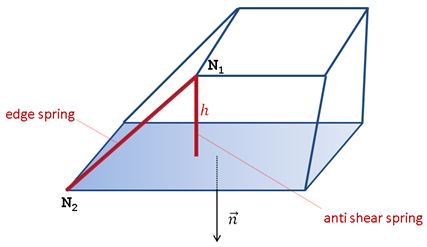/ALE/GRID/STANDARD |

|

|

|

|
|
/ALE/GRID/STANDARD |

|

|

|

|
Block Format Keyword
/ALE/GRID/STANDARD - Altair Grid Velocity Standard Formulation (2D and 3D)
Description
Describes the standard formulation for ALE grid velocity computation. It is an improved /ALE/GRID/SPRING formulation based on edge springs and anti-shear springs. (Comment 1)

(1) |
(2) |
(3) |
(4) |
(5) |
(6) |
(7) |
(8) |
(9) |
(10) |
/ALE/GRID/STANDARD |
|||||||||
|
|
|
lc |
|
|||||
Blank Format |
|||||||||
|
These springs are nonlinear elastic viscous. To ensure stability, their stiffness is computed from time step. The two types of springs are edge and anti-shear springs. Edge springs The forces for an edge spring are a function of its length variation during time.
Where,
h is the N1 distance from opposite face dt is the time step and k(h) is the spring stiffness k(h) = kcritical If h is inferior to the characteristic length lc and N1 is moving toward the opposite face then,
1/
otherwise,
Anti-shear springs The anti-shear forces are computed from node penetration. Gap is
and
Viscous Damping Viscous forces are computed from a critical damping corresponding to the upper bound for stiffness: 1/
Grid Velocity The grid velocity is then updated according to:
Where, m is fictitious mass on node from springs (automatically computed during Starter).
|